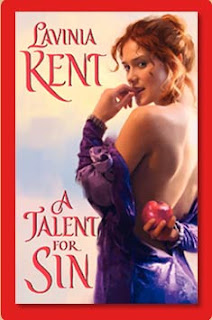 I am so delighted to introduce my very good friend, Lavinia Kent. I met Lavinia years ago when she came to one of her first Washington Romance Writer meetings. We ate lunch together and, as sometimes happens, I knew instantly that I’d made a new friend. Lavinia, Mary Blayney (Strangers Kiss, Sept 2009), Julie Halperson, and I were all writing Regencies and we had regular lunches together and yearly all day talk-fests at Mary’s house. Still do!
I am so delighted to introduce my very good friend, Lavinia Kent. I met Lavinia years ago when she came to one of her first Washington Romance Writer meetings. We ate lunch together and, as sometimes happens, I knew instantly that I’d made a new friend. Lavinia, Mary Blayney (Strangers Kiss, Sept 2009), Julie Halperson, and I were all writing Regencies and we had regular lunches together and yearly all day talk-fests at Mary’s house. Still do!
Diane
But this is an exciting debut for more than one reason! Read what others have said of A Talent for Sin. 
I was captivated by every page of A Talent For Sin by Lavinia Kent, a masterfully written book that brims with style and vitality—it is a sexy and emotional experience that will sweep you off your feet!”– Lisa Kleypas, New York Times Bestselling Author
“a refreshing romantic dynamic.”– Publisher’s Weekly
“4 1/2 Stars”– The Romantic Times
1. This is your debut novel, Lavinia! Tell us about your book.
I started writing this book because I wanted to do something different. As I’ve gotten a little older myself I’ve had a greater desire for more experienced heroines. One of the greatest things about being a writer is that when you long for a character you can create one.
Violet, Lady Carrington has actually existed since my first (unpublished) regency manuscript. I was shocked when I realized how much of her character I’d already laid out – three dead husbands before she was twenty-one, wealthy widow, likes younger men, very independent.
I took the basic idea of her and combined it with the desire to try to write a book that started with a sex scene – a relevant one. The first scene in the book – the excerpt on my website – is all about my hero showing he would do anything for Violet. All he wants is to make her happy.
2. We love to hear about a new author’s journey to publication. Tell us about yours and include your “The Call” story! Did being a four-time Golden Heart finalist help?
I’d actually gotten The Call after my first Golden Heart final and had turned the offer down on my agent’s advice. I don’t know if I would do the same thing again. I love where I’ve ended up, but it was an awfully nerve-wracking couple of years in between.
When I got The Call this time the biggest thing I felt was relief. I’d spent over two years wondering if I’d made a huge mistake. I actually got called by another publisher before Avon and was about to accept then when Avon called. It felt like a real dream come true moment. I think I danced for a week.
3. What was risky about your book?
I think the heroine was the riskiest thing about my book. I know that the romance world has changed, but writing about an unapologetic experienced woman who doesn’t have any wish to marry again still felt like it was pushing some boundaries.
There is also a risky scene where the heroine is being forced to sleep with another man. I wasn’t sure until I finished writing the scene what would happen. All I knew for sure was that the hero would love her anyway.
3. I read A Talent for Sin’s tantalizing excerpt and can guess about how you researched that! But tell us something about your other research for the book.
It sounds strange, but what I ended up researching the most was whether I could move the book forward a year in time. I’d written this book to follow an earlier book that had to happen over a certain period of dates. When this became the book that sold and it was separated from the first book all that changed.
One of my following books begins with George IV’s coronation and I needed the right amount of time between the books. I had to go through everything in this book to remove any reference that would have made changing the date impossible.
5. What is it about the Regency era that draws you to it?
I must confess that I’d actually intended to write Medievals. I was drawn to the idea of physical strength and political power being tied closely together. When I actually started to write, many of my friends were writing Regencies and I got sucked in. It is such a wonderful period it would be impossible not to be drawn to it.
6. What’s next for you?
I have another Regency, Bound by Temptation, coming out in February 2010. It’s the story of Violet’s brother. He was never intended to be a hero – in fact was more of a villain, but something about him just captured my interest. I loved being able to explain his side of the story.
I am also working on a proposal for the youngest sister’s story (the one that caused the timeline change). She’s still young, but has been through some really rough patches. If things work out she’ll end up with my favorite hero of them all.
I also have a second proposal in the works – but that one will just have to be a surprise.
I cannot wait for A Talent for Sin. You have a chance to win a copy, just by commenting here. So ask Lavinia some questions!

















